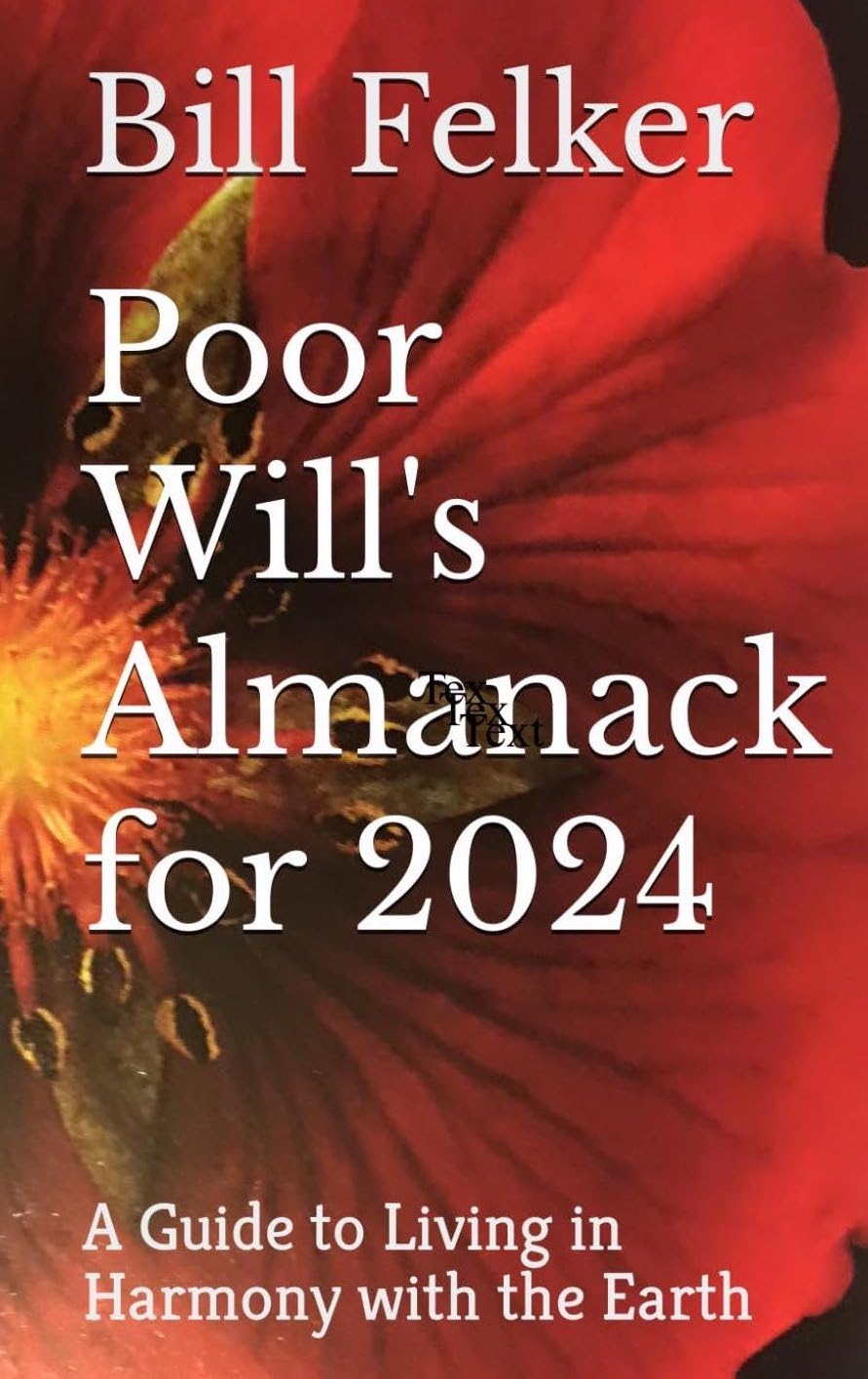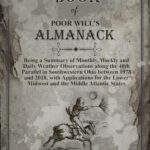Description
 Introduction to Poor Will’s Almanack
Introduction to Poor Will’s Almanack
SAstronomical Information
The sections on the Sun provides information on the Sun’s position in the zodiac as well as on solstices, equinoxes, the major eclpse of April 8, and cross-quarter days.
The positions of the four major planets (Venus, Jupiter, Mars and Saturn) are described so that the reader can identify these objects more easily in the night sky.
The names of the moons are unique to Poor Will’s Almanack, and they change each year. Data is provided concerning dates for phase changes.
Notes on the position of the stars offer brief overviews of major constellations. Dates for meteor showers are provided.
The Almanack Weather
The weather estimates in this Almanack are based on my charts of fractal weather patterns made between 1978 and 2023. Readers of my weekly and monthly columns throughout the United States have used these estimates successfully since 1984. The Meteorology section of each month in this Almanack describes the likely effects of the Moon and the regular passage of high and low-pressure systems.
The Weekly Weather sections provide weekly overviews of average conditions. Detailed weather outlooks for each day, week and month of the year can be found in The Weather Book of Poor Will’s Almanack, available on line.
The seasonal count section (Wintercount, Springcount, Summercount, Autumncount) offer additional information about the characteristics of the normal weather systems.\
Peak Activity Times for Creatures
The “Peak Activity Times for Creatures” section of each monthly section of the Almanack is a guide to lunar position and corresponding behavior.
Many people find that livestock, children, fish and game are more active (and dieting is more difficult) when the moon is overhead: at midday when the moon is new, in the afternoon and evening when the moon is in its first quarter, at night when the moon is full and in its third quarter, in the morning when the moon is in its fourth quarter. Second-best lunar times occur when the moon is below your location, 12 hours before or after those times noted above. The approach of weather systems (high-pressure systems typically preceded by low-pressure systems) also influences fish and animal activity.
Farming and Gardening
In general, planting crops that bear their fruit above the ground is recommended when the moon is waxing. Plant root crops, flower bulbs, trees and shrubs to promote root growth when the moon is waning. According to a number of studies, the moon exerts less influence on ocean tides and on human and animal behavior when it comes into its second and fourth quarters. Therefore, it might make more sense to perform routine maintenance on your flock or herd near the date on which the moon enters its second or fourth quarter. On the other hand, tidal lunar influences have been proven to be greater at full moon and new moon times. You might expect more trouble with your animals, therefore, on or about new moon and full moon. Livestock care should be less difficult during the relatively stable times between frontal systems listed in each month’s meteorology section.
The Seasonal Calendar
The Seasonal Calendar offers markers for the progress of the year throughout Midwest and East of the United States. If you keep track of what happens in nature in your yard and neighborhood, you will find many, many more points of reference that will provide a structure for living in harmony with the seasons.
The Seasonal Affective Disorder (S.A.D.) Index
This S.A.D. Stress Index is simply a way of measuring those natural phenomena which are assumed to be related to S.A.D. — the day’s length, the percentage of probable sunlight, and the weather. In order to create the Index, each of those factors was given a value from zero to 25, and then the three values were combined onto a scale of one to 75. Interpretation is simple: the higher the number, the greater the stress.
Index readings are most useful in combination with a record of your own moods. Reference to the Index when you feel out of sorts may be a way of getting a feel for how seasonal affective disorders influence your life.
Almanack Literature
Poor Will’s readers have been contributing to his weekly and monthly columns since 1985. People have submitted memory stories, outhouse tales, narratives about unusual occurrences and special animals. I include my favorite stories of recent years in each annual version of the Almanack. More stories are available on line in issues of Poor Will from previous years.
Sample Month
APRIL
2024
May I not serve, then, in Thy garden
And in Thy fields and farm,
Stirring the soil around the radishes
And pulling rhubarb by the fence?
Layering the Latham stems to make new growth
For warm sweet berries born two seasons hence?
Setting the tendril feet of runnered plantlets
In crumbled, tendered soil within the row?
Pausing to know the lilac’s dearness,
The gentle petalled rose upon my lips,
The lemon balm so sweet on fingertips,
And the sharp, wild scent of catnip cornered there.
Or, tractor mounted, turn the vibrant earth
Warm to the sun in overlapping layers
Of joy and productivity.
At star shine,
Crimson clover in stretching, wilting rows,
Cut at first bloom to hold all good within.
Quiet in star glow for tomorrow’s turning
To tomorrow’s sun.
Janet Stevens, “Joy”
The Gregorian Calendar
Solar Eclipse on High Street
August 21, 2017
As above, so below.
The Emerald Tablet of Hermes Trismegistus
Early in the afternoon of the solar eclipse, I was cutting zinnias, removing the older blossoms to encourage the plants to produce new flowers.
Sparrows chirped off and on and cicadas buzzed and cardinals and crows called once in a while. High clouds sometimes filtered the sunlight, but the day was bright and mild.
Henry Myers had called the day before. He said he had heard that birds stopped singing in the middle of a solar eclipse as though they thought night had arrived, and that when the sun came through the moon again, the birds resumed their calls.
As the eclipse progressed, the dense honeysuckles and the high locusts and hackberries and Osage that surrounded the yard took on an amber glow. It was not a vision of September so much as a transfiguration of summer to a new sepia season, a thin burnished time far from the decay of autumn.
Then I noticed the cicadas were quiet, and I heard no birds. While I stood surrounded by zinnias, bright red became deep blood-red, yellow became gold, orange became sienna, pink became violet, violet turned purple, bright white was soft and creamy.
And toward the end of it all, as the filter of the eclipse was weakening, two monarch butterflies (which had been so rare this August) suddenly appeared from over the trees, soared majestically into the yard and floated beside me among the zinnias.
Then one of the monarchs rose high, then swooped toward the other as though he could not hold back, and his consort rose steeply to meet him, and they spun in rapturous encounter, swirling up and around and across the flowers in tight randori.
Then they returned to visiting the flowers where I stood until everything became the way it once had been, and then they flew south over the house together. Cicadas buzzed again. Sparrows chirped. A cardinal sang. Towards the west end of town, crows called out.
The Sun
The year’s second Cross-Quarter Day is April 21, and it marks halfway between equinox and solstice. The Sun enters the Late Spring sign of Taurus on that day.
A total eclipse of the Sun will occur on April 8, visible in its entirety in a broad band from Texas through the Northeast. In much of Ohio, the eclipse will begin a few minutes before 2:00 p.m. (EDT), will reach its zenith at about 3:15 p.m. and end about 4:30 p.m. Check your local media for more details.
The Planets
Mars and Saturn in Aquarius are the earliest Morning Stars this month, followed by Venus in Pisces, which is the brightest of the Morning Stars. Jupiter in Aries is difficult to see morning or evening.
The Stars
The stars at bedtime tell that the danger of frost is almost past. June’s Arcturus still hangs a little to the east of the center of the sky, and that means a light freeze can happen one year in ten. But as that star shifts into the west, it pushes away the chances of freezing mornings with it. When Arcturus is well into the west at bedtime, any tender vegetable or flower can be planted without risk.
The Shooting Stars
The Lyrid Meteors are active after midnight between Cygnus and Hercules during the second and third week of April, peaking on April 23 and 24. These shooting stars often appear at the rate of 15 to 25 per hour.
Phases of the Termite Migration Moon
And the Tadpole Moon
April 1: The Termite Migration Moon enters its last quarter.
April 8: The Tadpole Moon is new.
April 15: The moon enters its second quarter.
April 23: The moon is full.
Peak Activity Times for Creatures
When the moon is above the continental United States, creatures are typically most active. The second-most-active time occurs when the moon is below the Earth. Activity is likely to increase at new moon and full moon and at perigee (when the Moon is closest to Earth), especially as the barometer falls in advance of cold fronts near those dates.
Date Best Second-Best
April 1 Midnight to Dawn Afternoons
April 2-7: Mornings Evenings
April 8-14: Afternoons Middle of the Night
April 15-22: Evenings. Mornings
April 23-30: Midnight to Dawn Afternoons\
The S.A.D. Stress Index
April brings the day’s length and the chances of mild weather into single digits on the S.A.D. Stress Index scale. Only the cloud column holds out at March levels, but that is not enough to keep the Index from dipping into the gentle 20s. By this point in the year, S.A.D. readings are not high enough to contribute to seasonal affective disorder unless a person is extremely sensitive to sunlight deprivation.
Key for Interpreting the S.A.D. Index:
Totals of:
75 to 65: S.A.D. Alert: Severe Stress
64 to 50: Severe to moderate stress
49 to 35: Moderate stress
34 to 25: Light to moderate stress
24 and below: Only people with extreme sensitivity to S.A.D. experience seasonal affective disorder below an Index reading of 24.
Day Clouds Weather Day Totals
April 1: 16 11 10 37
April l5: 14 8 9 31
April 30: 12 7 7 26
Meteorology
Seven major cold fronts move across the nation in an average April. Snow is possible in Northern areas with the arrival of the first three fronts. Average dates for the weather systems to reach the Mississippi: April 2, 6, 11, 16, 21, 24 and 28.
Major storms are most likely to occur on the days between April 1 and 11, and between April 19 through the 27. Although the intensity of the high-pressure systems moderates after the 22nd, be alert for frost at least two days after each system pushes through your area.
New moon on April 8, perigee on April 7 and full moon on April 24 can expected to intensify the weather systems and bring frost and flurries near those dates. In general, most precipitation usually occurs during the first two weeks of the month.
Weekly Weather
Week 1
Two major weather systems, one arriving on the 2nd and another coming in on the 6th, usually dominate the first quarter of April, and these fronts bring each day of the period a 40 percent chance of precipitation. April 3rd and April 5th are some of the wettest days of the month in the lower Midwest, carrying about a 60 and a 70 percent chance of precipitation respectively. Snow is most likely to fall (but only ten to 20 percent of the time) on the 3rd, 4th, and 5th. These three April days also bring an increased chance of strong winds.
There is a 20 percent chance of a high in the 80s this week all across the country’s midsection, and there is more than a 50 percent chance of an afternoon in the 60s or 70s. Still, daily chances of frost remain steady at an average of at least 35 percent throughout the period.
Week 2
Rain is the rule for April’s second quarter. After the third major high-pressure system passes through on the 11th, however, a brief mid- April dry spell typically occurs around the 12th, chances of precipitation falling to 25 percent. The 11th is the brightest day in the first half of April, bringing an 80 percent chance of sun, the best chances since the 7th of March. As for temperatures, chances of highs below 50 degrees fall to less than 20 percent on the 12th where they remain until they drop to ten percent on April 22nd. Milder highs above 60 occur better than half the time on all the days of this quarter except on the 10th, when cooler conditions typically prevail. Frost strikes an average of 30 percent of the nights.
Week 3
The chances of a high above 50 degrees are 75 percent on almost every day during April’s third quarter, and temperatures above 60 come at least half the time. Beginning on the 20th, the chances of an afternoon high in the 70s or 80s jumps from an average of 25 percent way up to 45 percent.
Rain or snow falls an average of 35 percent of the time this week of the year, the 15th, being the wettest day of all—carrying a 45 percent chance of rain and an additional 20 percent chance of snow.
Week 4
Late Spring arrives this week, the warm weather creating unmistakable markers in the progress of spring. Among those landmarks:
–The 26th and the 30th record freezing temperatures less than 15 percent of the time, the first time that has happened since late September.
–After the 22nd, chances of snow drop below five percent in most of the nation.
–Chances of a cold day in the 30s or 40s fall to only 15 percent on the 22nd; they plummet another five percent on the 26th.
–Beginning on April 27th, highs in the 90s become possible as far north as the Great Lakes, and the chances of a high in the 80s pass the 20 percent mark at lower elevations along the 40th parallel. The chances of a high above 70s degrees are now 50/50 or better for the first time this year.
–April 29th and 30th are usually the mildest days this week, with the 30th bringing a 90 percent chance of highs above 60 degrees for the first time since late September.
–The driest days at this time of year are April 26th and 27th, each with just a 20 percent chance of rain. The wettest days: April 29th and 30th –both carrying a 55 percent chance of precipitation.
Frostwatch
Between April 1st and June 1st, up to ten frosts occur at lower elevations along the 40th parallel during a typical year. Of course, some years, frosts end with March. But normally, the approximate chances of frost to strike after the dates listed below are:
April l: 98%
April 5: 95%
April 10: 90%
April 15: 80%
April 20: 75%
April 25: 65%
April 30: 50%
Springcount
Twenty-three major spring cold fronts cross the nation between the middle of February and the last week of May. Three passed through in February, and seven in March—the ten fronts of the subseason, Early Spring. The first six April weather systems belong to the subseason of Middle Spring. The seventh front introduces Late Spring.
April 2: This first weather system of Middle Spring is one of the more dangerous fonts of the year for tornados and hail.
April 6: Middle Spring’s second front also brings heightened chances of severe weather, but odds for milder conditions increase after its passage.
April 11: Watch for rain or snow ahead of this weather system, then sun and warmer afternoons.
April 16: Beginning with this front, a major increase in the average daily amount of sunlight takes place: a rise from early April’s 50/50 chance of sun or clouds up to a brighter 70 percent chance of clear to partly cloudy conditions.
April 21: Like the April 6th cold front, this front is yet another major pivot time for much more pleasant weather.
April 24: After this front passes, chances of frost virtually disappear in the South, become relatively insignificant throughout much of the North.
April 28: This is the first front of Late Spring. The April 28th front, and the first three of May bring the last serious chance of snow and a damaging freeze to strike along the 40th parallel.
The Seasonal Calendar
Every flower marks a different season,
Shows a hidden pattern, time and lesson.
Celtus
April 1: This is the week that white and pink and violet hepaticas reach their height of bloom at lower elevations of the southern Appalachians. Spring beauties, violet cress, harbinger of spring, bloodroot, bluebells, twinleaf, small-flowered buttercup, toad trillium, Dutchman’s britches, and even toothwort are coming in around them.
April 3: Plum trees are full of flowers, and the pears start to open. Quince, magnolias, crab apples, cherries, and the last of the cornus mas blossom, too. The peak period of pussy willow pollen begins, and some of the heavy golden catkins are falling in the wind.
April 5: Nettles and leafcup are six to eight inches tall when hepaticas are at their best. Asiatic lilies and columbine are three to five inches. Skunk cabbage leaves are more than half size, about ten inches long, eight across.
April 6: June’s chicory is six to nine inches high. Ragwort and garlic mustard are forming clumps; some sweet rockets and money plants are getting ready to send out their flower stalks. Hops vines twine around the honeysuckle. Japanese knotweed catches up with the rhubarb (just about big enough for pie).
April 7: In the waysides, common chickweed, dandelion, henbit, ground ivy, small-flowered bittercress, shepherd’s purse, and periwinkles blossom. Daffodils, scilla, pushkinia, anemone, and hyacinths are at their brightest in the lawns and gardens.
April 8: Toads are hopping. The rare grouse is drumming. Downy woodpeckers are mating. Baby groundhogs have come out of their dens. In backyard ponds, the koi and frogs have ended their hibernation. Water rushes and purple loosestrife, water lilies and pickerel plants have suddenly produced foliage. Water striders are courting now, and small diving water beetles hunt for food.
April 9: Patches of wild geranium leaves glow with an orange tint in the sun. Sedum is budding. Stalks are forming on the sweet rocket. Cowslip is just opening. Daffodils and grape hyacinth hold on from March. Buds on the grape vines are flushed and swollen.
April 11: Privets are filling out. Branches of the multiflora roses are almost completely covered with foliage. Pale spikes of lizard’s tail are as long as dragonflies.
April 13: Asparagus is big enough for supper. American toads are chanting, and tadpoles are already swimming in the backwaters. Young hummingbird moths and bumblebees come out to sip the annual mass flowering of dandelions. Gnats become bothersome.
April 14: Snakehead mushrooms, which have a tall, light-colored stalk and a small, dark cap, begin to appear now, and their season typically lasts through the end of the month. Throughout the country’s midsection black and gray morel mushrooms generally come up at this time of the month.
April 16: This is usually apple blossom week along the 40th parallel, and redbud week, and dogwood week. By this time of the year, honeysuckles and spice bushes have developed enough to turn the undergrowth pale green, and color rises throughout the tall tree line.
April 18: Pheasants nest, and bird migrations peak with the arrival of whip-poor-wills, red-headed woodpeckers, catbirds, cedar waxwings, yellow-throated vireos, meadow larks, indigo buntings, scarlet tanagers, Baltimore orioles, cowbirds, kingbirds, and more than a dozen varieties of warblers.
April 19: In the Northwest, Kestrel hawks are nesting, and aspens flower. Wood ticks follow the receding snow, and grizzly bears come out of hibernation. Sand hill cranes migrate through the Western wetlands. In Vermont, trout fishing time begins. The crocuses are blooming in Minneapolis. Azaleas are open in Norfolk, rhododendrons in St. Louis. Dogwoods are at their best in Atlanta. New Orleans is all decked out like an Ohio June. Along the north Atlantic coast, mackerel move toward inshore waters.
April 21: This is the time the antlers of white-tailed deer begin to grow. The first parsnips bloom, and all major garden weeds are sprouting. Honeysuckles and spice bushes have developed enough to turn the undergrowth pale green, and rose of Sharon, ginkgo, elm, tree of heaven, black walnut, pussy willow, box elder, sweet gum, ash, locust, and mulberry start to change their flowers for foliage.
April 24: Early daffodils are almost gone, along with the scilla and the windflowers. The season of grape hyacinths is over. Some of the earliest Middle Spring wild flowers are holding on in the North: a handful of bloodroot and twinleaf, some toothwort, Dutchman’s britches, violet cress, periwinkle, henbit.
April 26: Yellow-bellied sapsuckers mate as buckeyes come into bloom. Admiral butterflies hatch. Azaleas blossom in the warmest Aprils just as field grasses and winter wheat become long enough to ripple in the wind. Chickweed starts to fill in the woodland floor.
April 28: Hepatica sprouts new leaves as it comes to the end of its cycle. When that happens, wood mint is tall and sweet for tea.
April 30: The first wave of songbird migration reaches Lake Erie; it is dominated by the males of the white-throated sparrow, ruby-crowned kinglet, yellow-rumped warbler, black-and-white warbler, palm warbler, Nashville warbler, swamp sparrow, and hermit thrush.
Farming and Gardening
Best lunar conditions for field crop, frost-seeding, and other pasture planting occur as the moon waxes. All across the country, oats and spring barley are being put in the ground. Spring wheat is being seeded in New England, sugar beets all across the northern states. Field corn planting is in full swing throughout the South and the central states, cotton planting along the Gulf.
Fertilize your pastures at least two weeks before you let your livestock out in them. Keep an eye out for bloat, however, as you let your kids, calves and lambs enjoy the new greenery.
Recommended lunar practice is to shear sheep, and dehorn, castrate, tattoo and dewattle your young goats late in the moon’s third quarter or during the fourth quarter.
Also during this period of the waning moon, destroy tent caterpillars as they hatch. Protect new foliage from aphids. Watch for weevils in the alfalfa. Be on the lookout for cutworms and sod webworms in the corn. Be careful when you spray the fields: don’t contaminate the pastures, and try to keep from harming pheasants and woodcocks that are nesting now along the fence rows.
Almanack Literature
The Independence of the Backyard Gardener
“I put myself to sleep looking at seed catalogues and dreaming and making plans. I read gardening magazines like my mother used to read the Bible.”
Bev Price, a retired teacher, had been waiting for a garden most of her life. Then she finally moved into a house where she could try her hand at vegetables and flowers.
“That first breaking of the soil was beautiful. I hadn’t known what summer was all about.I used to teach in the summer. It was almost like I was afraid to be alone with myself. I was afraid to stop working.
“Then it was wonderful to find I really had so much I could do right here. I loved it. I was discovering things I loved to do.
“I never played in the dirt much when I was a kid. Now I love the smell and the feel of the earth in the spring. There’s something about it that gives me energy.”
Bev reflected on her visits to England and to English gardens: “I love how they use space. When space is at such a premium over there, they use every crack. Nothing goes to waste.”
Her own garden is a personalization of space: “Just a year or so ago I discovered ‘square foot gardening,’ and now I have raised beds in the garden, three 4 X 3-foot beds. There is a trellis on the north side of each bed.
“Then I plantd strawberries, and Concord grapes. They are another whole treat. After that, I began a rose bed. The roses and vegetables and fruits are in rectangles; herbs in a square; circles for perennials and annuals.
“The space behind the shed: I made a compost pile there, wrapped chccken wire around some iron posts. There are so many spaces I could still work on….”
Bev divides much of her free time between gardening and quilting. She sees a relationship between the two.
“The yard, the earth, has a texture like a quilt. And gardening is like quilting. It’s the gardening I love as much as the garden. It’s the quilting process I love a much as the quilt. It’s the planning and choosing fabrics and seeds, dreaming of the texture.
“And this is why I loved teaching too, because you are dealing with creation and with growing things.You have to learn patience, of course. You cant ever make plants do anything. You have to keep learning about them…it’s so much like teaching and working with children.”
Bev’s summer days are aesthetic and free: “I’m up at dawn I can hardly wait to get outside. It’s like everything has changed overnight.
“I love to walk through the yard barefoot. I like it when no one else is awake. That’s when I do all my picking, when things still have a little dew on them. Then I sit outside for breakfast. I feed the birds.
“By that time, everybody else is up. That’s when the real work begins. There’s always cleaning up to do, rearranging. I work on the compost pile. I rearrange the perennials. I keep moving them from one bed to another. Then I have to look at everything. I never rush.
“Around two in the afternoon, the hottest time of the day, my other process begins. I go in the house and start on my quilts. I do all the piecing and planning in the summer, the quilting itself in the winter.”
But there’s more even than schedule and beauty to what Bev does. There’s independence: “I bet I don’t go to the store but once a month now in the summer. I would like not to depend on anyone for anything.”
And there’s “finding a way back to the world after technological divorce has severed us from contact with nature.
“There’s love too,” she said. “A garden is like a dog. You have to love it.”

Only logged in customers who have purchased this product may leave a review.







Reviews
There are no reviews yet.